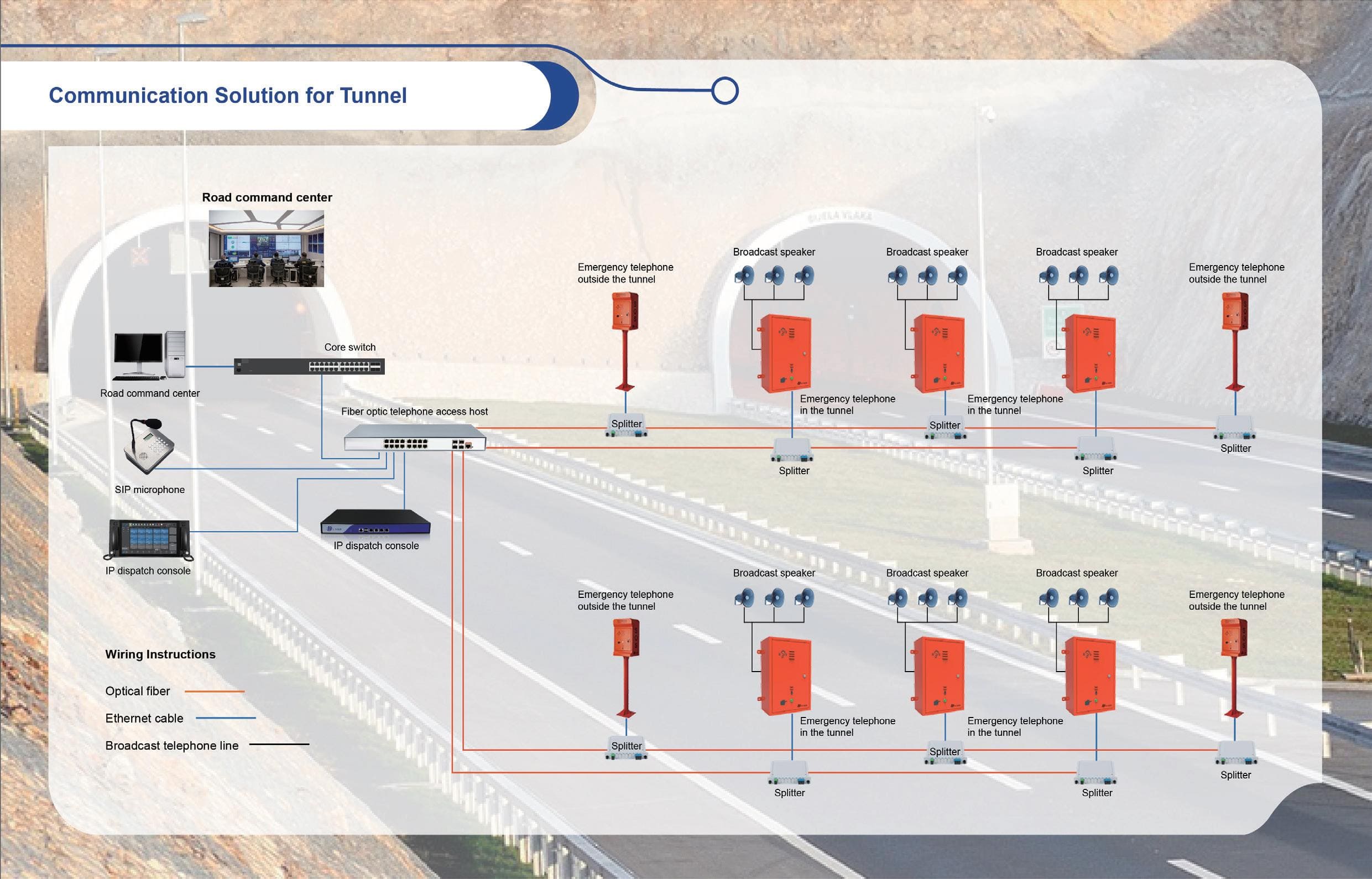Understanding the Integrated Tunnel Communication System for Emergency
In an age where infrastructure requires not only strength but also intelligent systems for safety, an Integrated Tunnel Communication System for Emergency emerges as a crucial component. This system is designed to ensure safe communication within tunnels during emergencies. It plays an indispensable role in managing crisis situations, providing clear channels for coordination among various stakeholders. Whether it is a fire, an explosion, or a hazardous materials leak, an effective communication system is essential for minimizing risks and enhancing safety. To learn more about its functionalities and importance, you can explore the Integrated Tunnel Communication System for Emergency.
What is an Integrated Tunnel Communication System for Emergency?
The Integrated Tunnel Communication System for Emergency is a network of advanced communication technologies and protocols, designed specifically for use in tunnels. This system facilitates real-time information exchange between safety officials, emergency responders, and tunnel users during potential crises. At its core, the system seamlessly integrates various communication mediums, such as loudspeakers, intercom systems, and visual display boards, to provide a unified platform for emergency management.
Unlike traditional communication systems that may struggle with signal penetration in enclosed spaces, an Integrated Tunnel Communication System is purpose-built to work efficiently within significant structures like tunnels, ensuring that messages get through even in challenging environments.
Key Components and Functions
An effective Integrated Tunnel Communication System includes several vital components, each serving a specific function:
- Control Center: The nerve center for managing communications, comprising trained staff who monitor and coordinate emergency responses.
- Public Address System: This ensures announcements are heard clearly by all tunnel personnel and users, providing critical instructions during an emergency.
- Video Surveillance: Cameras placed strategically allow continuous monitoring, offering real-time visual assessments of incidents.
- Emergency Intercoms: Positioned throughout the tunnel, these devices enable users to communicate directly with emergency responders.
- Signal Booster Systems: Reinforces communication signals in areas prone to dead zones, ensuring uninhibited transmission of emergency messages.
These components work synergistically to provide a robust communication network that enhances situational awareness and ensures rapid actions during emergencies.
Applications in Emergency Situations
The applications of an Integrated Tunnel Communication System for Emergency are vast, encompassing various scenarios that require immediate and effective response strategies. Some examples include:
- Fire Incidents: During a fire, timely announcements and clear instructions can drastically reduce panic and facilitate orderly evacuations.
- Traffic Accidents: In the event of a collision within a tunnel, the system can alert emergency services swiftly, reducing response times and potentially saving lives.
- Hazardous Material Spills: Communication systems play a critical role in managing such spills, ensuring that proper containment measures are initiated without delay.
- Terrorism Threats: In high-risk scenarios like terrorist attacks, the ability to communicate rapidly and efficiently can be the difference between life and death.
The diversity of applications illustrates the necessity of an Integrated Tunnel Communication System, highlighting its significance in modern tunnel operations.
Benefits of Implementing Integrated Tunnel Communication System for Emergency
Improved Response Times and Coordination
One of the most significant advantages of implementing this system is the enhancement of response times during emergencies. The Integrated Tunnel Communication System ensures that critical information circulates quickly among emergency responders, thereby facilitating timely actions and effective coordination. For instance, pre-configured emergency protocols can trigger automated alerts to relevant personnel, ensuring immediate attention to the nature of the incident. By adopting such systems, tunnels can drastically reduce response time and improve overall efficiency in crisis management.
Enhanced Safety Protocols
Safety is of paramount importance in tunneling operations, making the implementation of integrated communication systems vital. These systems not only ensure that emergency personnel can communicate effectively, but they also bolster safety protocols by providing real-time updates and alerts. During emergencies, users can receive vital information on evacuation routes, hazard information, and safety instructions, reducing confusion and chaos. The ability to relay critical safety messages clearly and promptly can significantly enhance overall occupant safety.
Cost-Effectiveness and Maintenance
Investing in an Integrated Tunnel Communication System for Emergency can actually lead to long-term cost savings. While the initial deployment may appear substantial, the system’s capacity to mitigate disaster impacts pays dividends by reducing potential liabilities, fines, and lawsuits following emergencies. Additionally, with regular maintenance and updates—essential components of any effective system—tunnel operators can ensure that the technology remains functional and secure, minimizing unexpected repair costs. The reliability of such systems reduces the need for extensive training modifications, further contributing to cost-effectiveness.
Challenges in the Deployment of Integrated Tunnel Communication System for Emergency
Technical Limitations and Solutions
Despite the clear advantages, deploying an Integrated Tunnel Communication System can present certain technical challenges. Issues such as signal interference and insufficient infrastructural support can hinder effective communication. Solutions involve thorough site assessments to gauge existing conditions and determine optimal locations for signal boosters and devices. Additionally, investing in robust technology capable of withstanding tunnel-specific challenges is crucial. The deployment team might also consider creating a hybrid communication model that uses both wired and wireless solutions to enhance overall system reliability.
Training and Workforce Preparedness
Training personnel to effectively use integrated communication tools is another challenge faced during deployment. Emergency responders must be proficient in system operation and familiar with protocols. Regular training sessions and simulated emergency drills are vital to ensure preparedness. Such training enhances confidence and reduces the likelihood of errors during a real crisis, ultimately fostering a culture of safety within the organization. Partnering with experts or using specialized training programs can further strengthen workforce readiness.
Integration with Existing Systems
Integrating the Integrated Tunnel Communication System with pre-existing emergency response frameworks can be complex. Addressing compatibility issues with older technologies and ensuring a smooth transition to newer systems requires careful planning and execution. To mitigate these challenges, it’s essential to approach integration with a comprehensive evaluation of current systems and a clear blueprint for implementation. Engaging with system architects can ease the process by leveraging best practices gleaned from previous implementations and ensuring that newer features mesh well with legacy systems.
Best Practices for Operating Integrated Tunnel Communication System for Emergency
Regular Maintenance and Updates
Like any robust system, the Integrated Tunnel Communication System for Emergency requires ongoing maintenance and updates to ensure peak performance. Regular inspections, software updates, and prompt repairs of malfunctioning components are essential. Developing a maintenance schedule that includes both routine checks and emergency drills can ensure that the system remains operational and reliable at all times.
Training Programs for Emergency Personnel
As emphasized earlier, ongoing training for all personnel involved in emergency response is essential. Implementing periodic retraining and workshop sessions can help upgrade skills and knowledge on new features of the Integrated Tunnel Communication System. By establishing a training regimen that includes certifications, tactical drills, and scenario-based exercises, organizations can boost competence and readiness among responders, ensuring that all are familiar with how to utilize the system in various situations.
Implementation of Feedback Loops
Creating feedback loops within the system helps facilitate continuous improvement. Emergency responders and tunnel management teams should regularly evaluate system performance, collecting input on functionality, ease of use, and overall effectiveness during drills. By fostering an environment of open communication, organizations can make necessary adjustments and improvements based on firsthand feedback, ensuring that the system adapts over time to changing needs and scenarios.
Future Trends in Integrated Tunnel Communication System for Emergency
Advancements in Technology
The rapid pace of technological advancements is poised to revolutionize the Integrated Tunnel Communication System for Emergency. The integration of AI and machine learning can enhance predictive analytics, enabling personnel to anticipate incidents before they occur. Innovations in wireless communication, coupled with improvements in sensor technology, will also redefine how information is relayed during emergencies, ensuring that responders have access to critical data at their fingertips.
Enhanced Data Analytics for Improved Decision-Making
As data becomes increasingly integral to decision-making in emergency response, effective data management systems will bolster the efficacy of Integrated Tunnel Communication Systems. By leveraging analytics, organizations can identify patterns from numerous incident reports, leading to improved safety protocols and the capacity to make informed decisions quickly. The future will likely see systems that not only communicate alerts but also analyze data for actionable insights, thereby fostering a more dynamic response strategy.
Sustainability and Resilience in System Design
Sustainability has emerged as a critical focus in infrastructure development, including communication systems. Future systems will prioritize energy efficiency and incorporate renewable resources to minimize environmental impact. Moreover, the design of these systems will involve resilience against various challenges, ensuring that they can withstand both operational and environmental stresses. This focus on sustainability will not only enhance the longevity of communication systems but also align with broader goals of environmental stewardship in urban development.













Leave a Reply